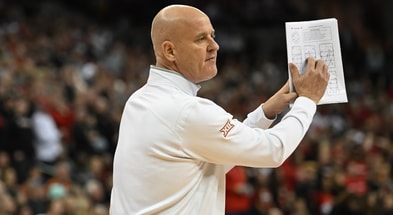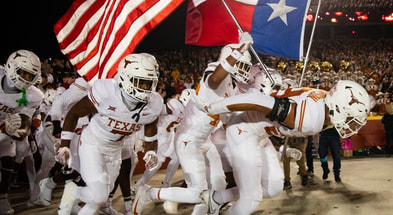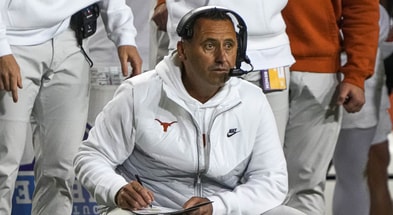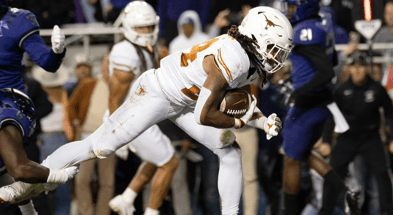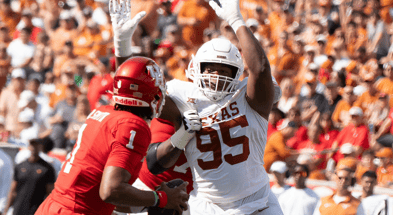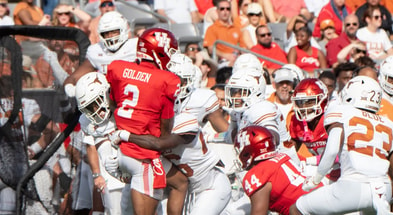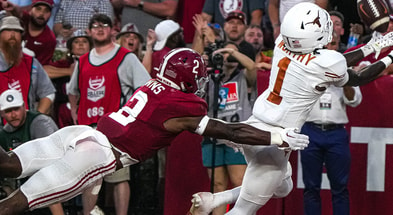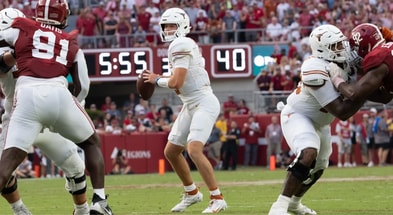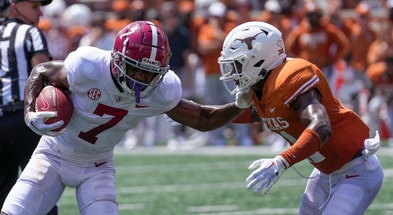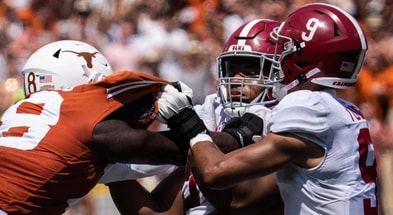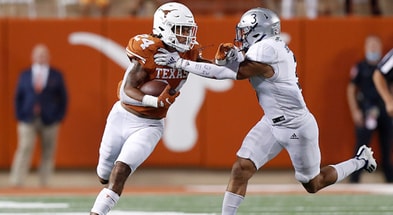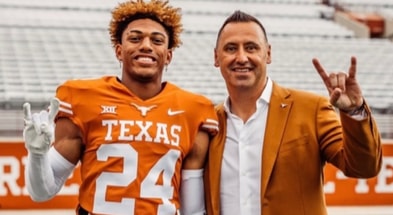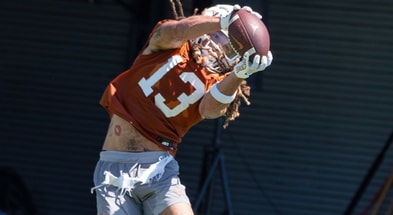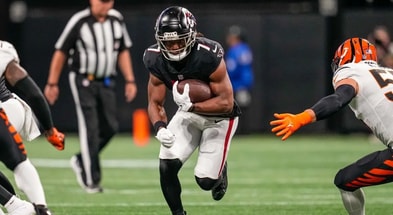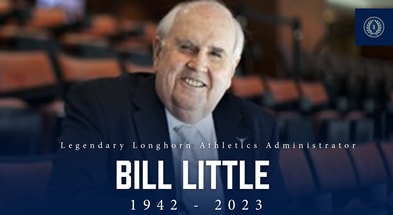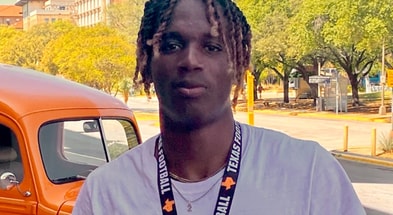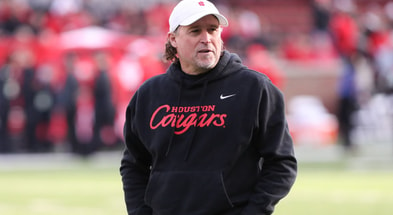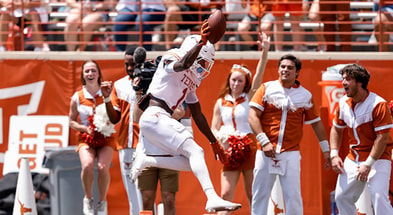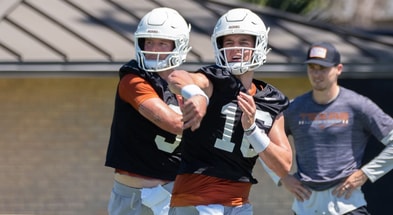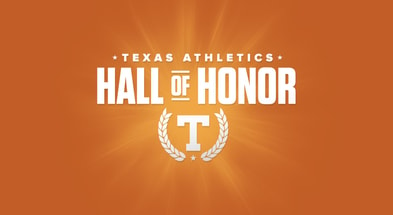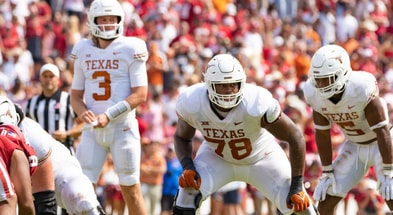X's and O's glossary for the Steve Sarkisian era
The X’s and O’s of football often seem like an entirely different language.
Sure, if you were to say “the back followed his blockers before bouncing it outside and juking a defender,” it’s not hard to get a sense of what’s going on. If you were to say “they ran inside zone against a four-man front, the OL was able to neutralize the DT and NT, move up to the linebackers, and the back cut outside once the safety committed to corralling him one on one,” the X’s and O’s on the chalkboard start to come to life.
I have put together a list of all the relevant terms to 2021 Texas’ offense, defense, strategy, and deployment. Use this as a resource and feel free to ask about any other terms I might have overlooked.
The Steve Sarkisian offense
Positions
12/11/20/21 personnel: The trick to understanding a term like “12 personnel” is to know which numbers mean what. The first number indicates how many running backs (including fullbacks) are on the field, the second number indicates how many tight ends are on the field. So 11 personnel has one running back and one tight end, you can safely assume the other nine players include five linemen, three wide receivers, and a quarterback.
20 personnel is two running backs and no tight ends, 21 personnel has two running backs and one tight end. Texas is going to base in 12 personnel, which means two tight ends, but one of those tight ends will have a hybrid role which may ask him to play as a tight end, fullback, or receiver.
“Y” tight end: Sarkisian teaches his offense as a 12 personnel system, although they will use other personnel packages including heavy doses of the more familiar 11 personnel Texas fans are accustomed to seeing. The “Y” tight end usually lines up on the line of scrimmage attached to an offensive tackle on the edge like a traditional tight end.
Expected starter: Jared Wiley
“H” tight end: The other tight end, the “H” is more of an off-ball tight end who can move around more easily since he’s not on the line of scrimmage. He can be a moving blocker who serves like a fullback or he can flex out of the box and run routes like a receiver.
Expected starter: Cade Brewer
“X,” “Z,” and “H” wide receivers: In the Tom Herman offense, the X receiver was the outside receiver to the boundary and Z was the outside receiver to the field.
In Sarkisian’s offense, as a general rule the X receiver is the outside receiver to the side of the field with the H while the Z receiver stays attached to the Y.
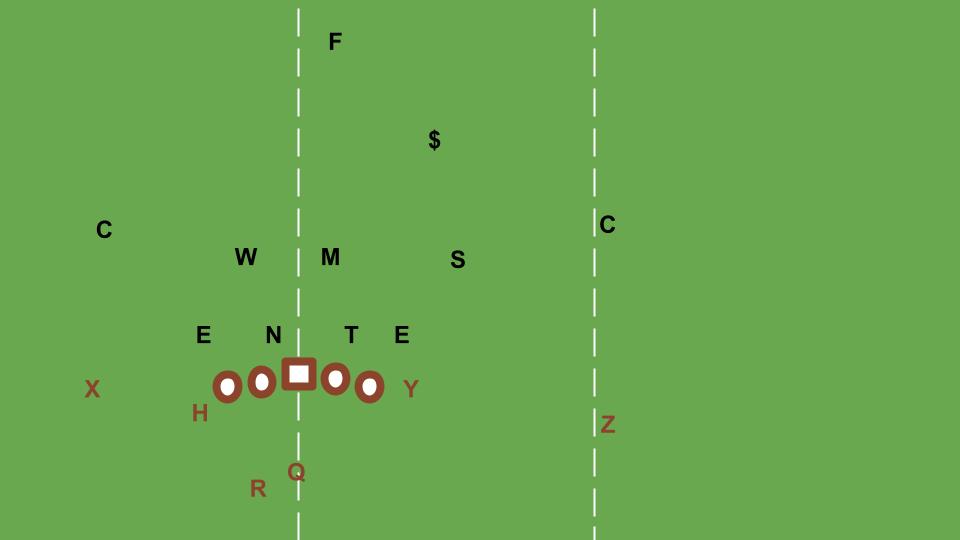
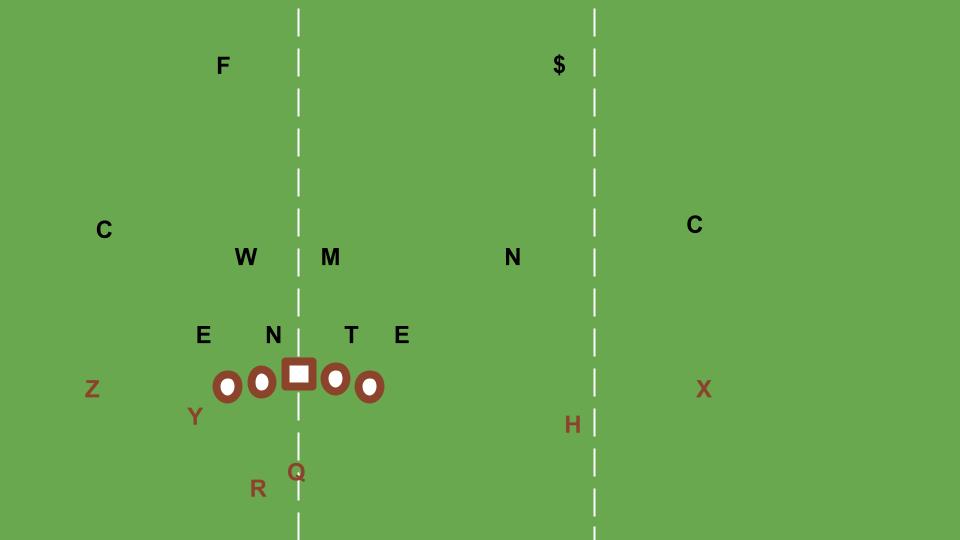
Concepts
Inside zone: This has been the main running concept at Texas for much of the last two decades and will likely remain so under Sarkisian and offensive line coach Kyle Flood. The idea is for the offensive line to take quick lateral steps in unison before working to drive the defensive line backwards and off the ball, particularly where there are double teams, in order to generate creases for the running back going north and south. The running back aims for the A-gap when he gets the ball and then makes a cut based on his read of how the linebackers are responding.
Wide/outside zone: Outside zone can be run a lot of ways but the general gist is for the offensive line to take much wider, lateral steps than in inside zone and focus more on lateral movement to create creases than using double teams to drive defenders backwards. The running back aims for the perimeter and makes a cut based on whether the offensive line is reaching defenders to the side they stepped to or not.
Gap schemes: There are two main gap schemes in football “power” and “counter.” In “power,” a tight end or fullback will block the defensive end while an offensive lineman (usually the guard) pulls from the opposite edge to lead a path for the running back on a trajectory based on the tight end/fullback’s block. In “counter” the pulling lineman blocks the defensive end and then a tight end, fullback, running back, or another offensive lineman (GT counter) pulls behind him to be the lead blocker.
Duo: One of the most confusing plays in football, duo is considered a “gap” scheme and often referred to as “power without a puller” but is often indistinguishable from the more downhill varieties of inside zone. But true duo typically involves two tight ends, long-lasting double teams rather than the quicker combinations in zone blocking, and a targeted linebacker being left unblocked for the running back to read.
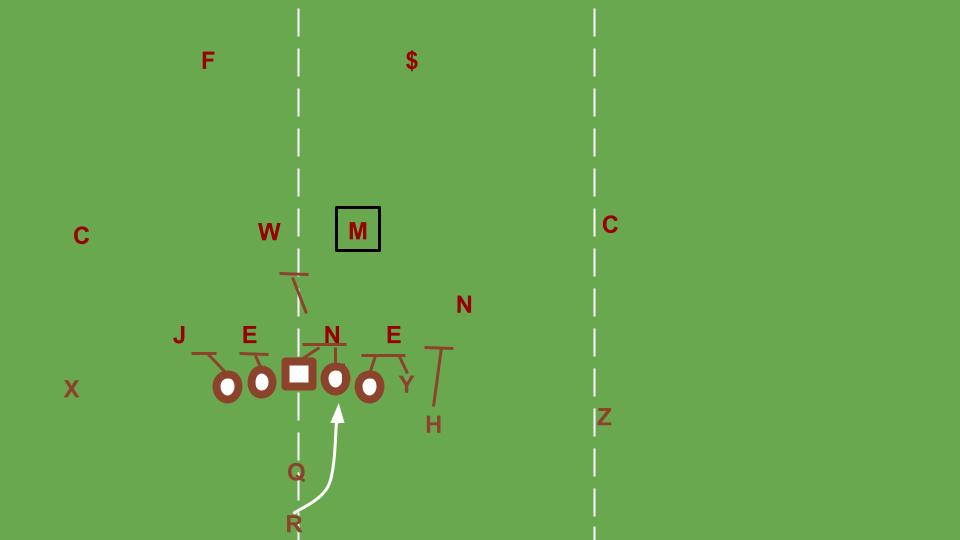
RPO: “Run/pass option.” A play where the quarterback reads a “key” defender to tell him whether to hand off to the running back on a normal run scheme or to throw a quick pass.

Mesh: A popular concept for beating man coverage Steve Sarkisian has embraced along with much of the rest of the football world. The running back runs a wheel route of the backfield while the receivers cross paths over the middle of the field with the aim of freeing someone by a “rub” or confusion.
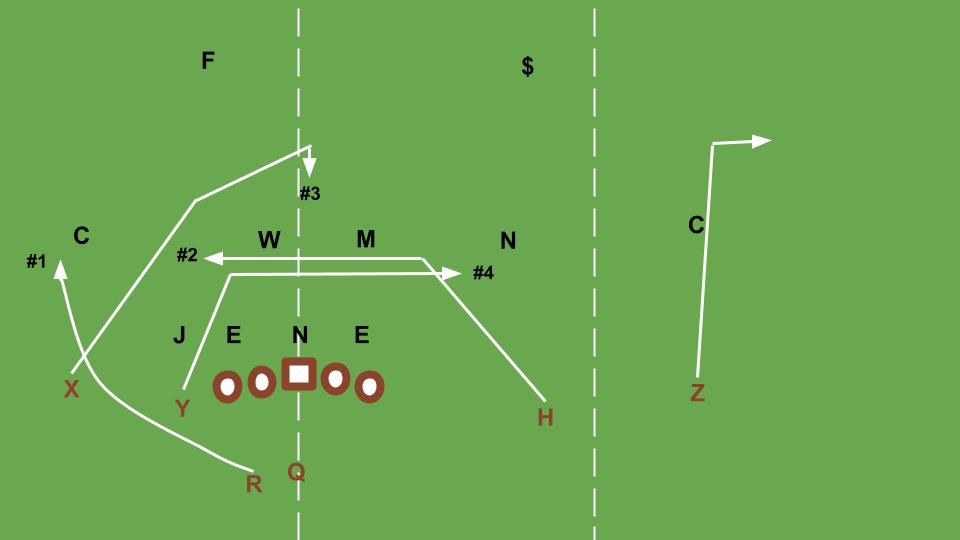
The Pete Kwiatkowski defense
Positions

Jack linebacker: In Pete Kwiatkowski’s 2-4-5 nickel package, the two edge positions are manned by defensive end/outside linebacker hybrids. The “Jack” is usually the bigger of the two and lines up to the wide “field” side of the formation.
Expected starter: Jacoby Jones
Buck linebacker/X-backer: The “boundary” or short side defensive end/outside linebacker hybrid in Kwiatkowksi’s 2-4-5 nickel package. He’s more of a true weakside edge than the hybrid Jack position.
Expected starter: Ray Thornton
Nose tackle: As is the case with most defenses, the nose tackle in the Kwiatkowski defense is expected to plug A-gaps inside. Kwiatkowski has multiple fronts but is a big fan of lining up his nose across from a guard in a 2i-technique (inside eye of the guard). From there he can grapple with the guard and keep him from advancing to the linebackers.
Expected starter: Keondre Coburn
Defensive tackle: The defensive tackle usually lines up as a 3-technique for Kwiatkowski but he’s very multiple, preferring to be able to move his players around to thwart offenses. The tackle can be a big, powerful grappler like the nose but he can also be aligned and deployed as more of a disruptor, shooting gaps.
Expected starter: Moro Ojomo
Mike linebacker: The field side inside linebacker in Kwiatkowski’s defense. The Mike has to be able to cover some ground going backward and even laterally because he has more space outside of him.
Expected starter: Luke Brockermeyer
Will/Dime linebacker: The boundary side inside linebacker in Kwiatkowski’s defense. This position has less space to cover than the Mike linebacker but he still needs to be able to make good, deep drops in coverage. Because the Will/Dime player is typically a bigger, heavier player he’s also used regularly on the edge in the blitz package.
Expected starter: DeMarvion Overshown
Sam linebacker: This position only plays in base personnel, which is a sort of 3-4/4-3 hybrid system, and plays instead of a nickel defensive back. He’s closer to the line of scrimmage aligned to the wide, “field” side. The Sam plays when the defense wants a bigger body to help set the edge when the offense puts tight ends and fullbacks on the field.
Expected starter: Ovie Oghoufo OR Ben Davis
“Star” or nickel: A defensive back who aligns to the wide side of the field and is mostly occupied either by covering the wider spaces there or the slot receivers who work in that space. The nickel is close enough to the box to be a regular part of run support but also needs to be athletic and skilled enough to stick to inside receivers in man coverage.
Expected starter: Anthony Cook
Free safety: Kwiatkowski’s free safety aligns to the wide side of the field with the nickel and has similar responsibilities, although he’ll play more deep coverage than the nickel.
Expected starter: B.J. Foster
Strong safety: The strong safety stays in the shorter “boundary” side of the formation and is much more of a potential “box safety” or “alley safety” and regular run support defender than the free safety or nickel who play in more space.
Expected starter: Brenden Schooler
Cornerbacks: The Kwiatkowski corners are very similar to cornerbacks in other defensive schemes although this system teaches them to have eyes on the quarterback more than most defenses. They will probably play left and right with the better player at left cornerback.
Expected starters: Josh Thompson and D’Shawn Jamison
Concepts
Kwiatkowski is a big believer in having multiple fronts to allow the defense to match up with offenses based on concept and strengths and weaknesses in either the Texas personnel or that of their opponents. So he’ll use each of the following fronts and a few others
The Over/Under front: The Over and Under are the two main 4-down fronts of football. Traditionally, the Over front would set the 3-technique defensive tackle (lined up in the B-gap between the tackle and guard) to the same side of the formation as a tight end. The Under front would use a bigger 5-technique (outside of the offensive tackle) to the tight end side, then the nose while the 3-technique would be on the opposite weak side.


Kwiatkowski will use both fronts and move the 3-technique around but may often have the 3-technique to the boundary and the nose in a 2i-technique to the field. This is a sort of modern Under which defines the offensive strength by the wide side of the field rather than the alignment of the tight end. For Texas this would put Coburn to the field and force opponents to successfully block him in order to prevent the Mike linebacker from having a free run at any play trying to get to the wide edge. They’d be a traditional “Over or Under” based not on their own call but where the offense chose to put their tight end.
The tite front: This is a 3-down front and was the preferred base front for Todd Orlando. It utilizes two big, 3-down defensive ends who line up in 4i-techniques (inside eye of the offensive tackle) and defend the B-gaps against the run but have to get outside on the edge when rushing the passer.
Bear/46 front: The “46 defense” was a scheme used by the 1985 Chicago Bears when they won a Super Bowl with their dominating defense. The gist of it was to put a 3-technique on both sides of the formation and cover every offensive lineman with a defensive lineman across from him. With everyone getting a 1-on-1 matchup it could make life very difficult for the offense either in finding ways to double team good players or in trying to pull lineman without letting someone run free through the backside.

Nowadays the 46 is typically a situational defensive formation, used most often for passing situations when the defense wants to prevent the offensive line from knowing who to block.
Match 3 coverage: Match 3 is the modern way to run good, old fashioned cover 3 defense. There’s a deep safety to stop post routes, the corners don’t have help over the top and need to keep receivers in front of them, and then underneath there are two curl/flat zones located from the hash marks to the sideline and two hook zones from the hash marks inside. Typically the inside linebackers cover the hook zones and then outside linebackers or defensive backs handle the curl-flat areas.
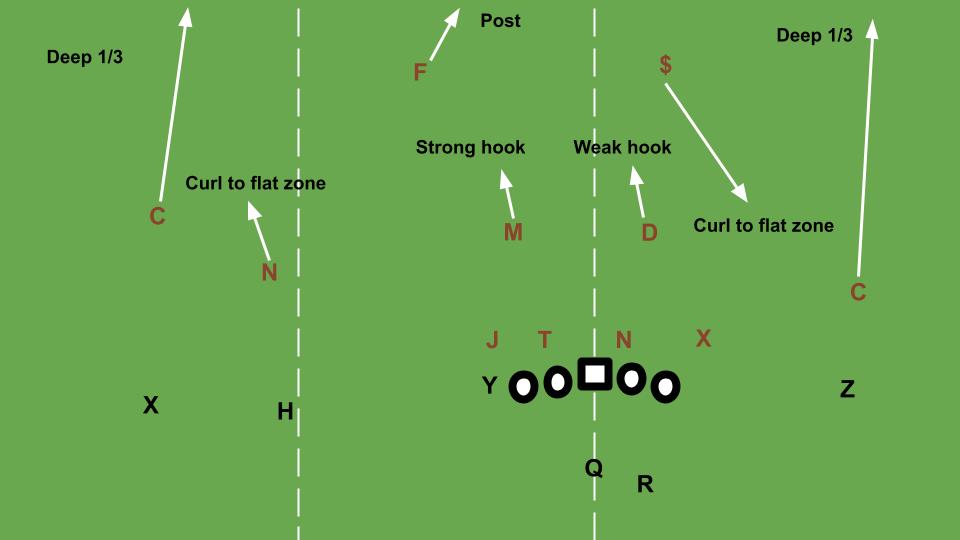
In Match coverage, everyone has assignments similar to those traditional zones but instead of just dropping to a spot of grass they will “match” routes. So an assignment for a defender is often “cover this receiver unless he does this and leaves your zone, in that case look for a new receiver to cover, probably coming from the guy over there.”
The goal in Match coverage is to get the best of both man-free and cover 3.
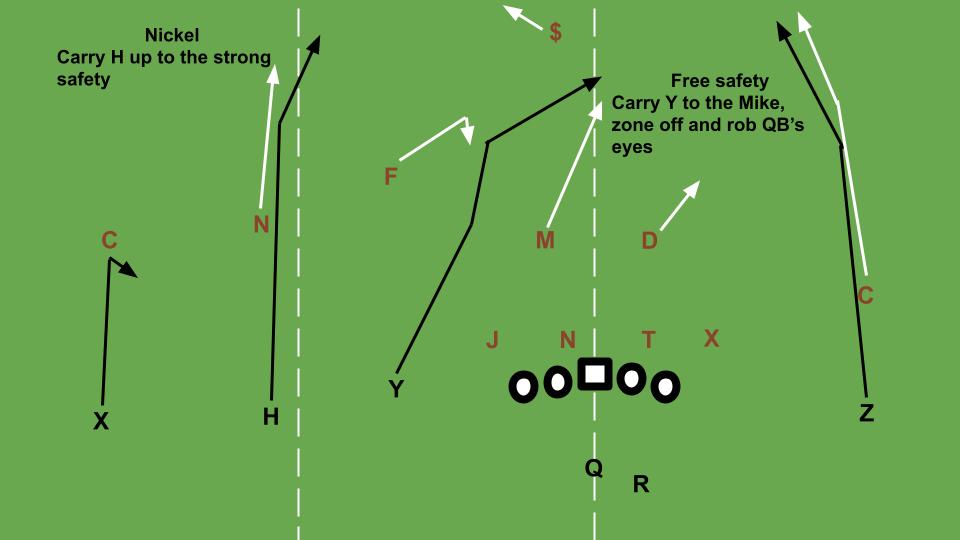
Vision quarters: A brand of quarters coverage Pete Kwiatkowski brought from the Pacific Northwest. Quarters coverage essentially boils down to covering deep routes from outside receivers with cornerbacks and from inside receivers with safeties with roles shifting based on the coverage rules and the routes receivers run.
“Vision quarters” utilizes less precise pattern-matching rules than other brands and has cornerbacks and safeties stay over the top of their assignments while keeping their eyes on the quarterback. The goal is to allow defenders to jump routes and force quarterbacks to hold onto the ball while avoiding getting beat over the top.
Zone blitz: A zone blitz is one in which the defense drops a defender the offense was expecting to rush the passer while blitzing a defender expected to be playing coverage. Manny Diaz, Charlie Strong, Todd Orlando, and even Chris Ash to a certain extent were all fans of the “fire zone blitz”.
The fire zone would rush five defenders after the passer, drop three defenders into the normal three deep zones of a cover 3 defense, and then have three defenders underneath with specific rules about what to cover. The fire zone was regularly shredded by spread offenses which could flood underneath routes with too much speed in too much space for the three underneath defenders to handle.
Pete Kwiatkowski is also a fan of the zone blitz, and will use the fire zone, but is a bigger fan of zone blitzing with four.

This is the same Match 3 defense PK prefers to play every down, the difference is there’s some movement and confusion for the offense about who to block and who will cover than a typical four-man pass-rush.
Here’s a handy guide courtesy of PFF that explains where each gap is and where defensive techniques line up.

Additional questions? Ask away on the Inside Texas Members board.
Joe Cook contributed to this story. Cover photo by Will Gallagher for Inside Texas
